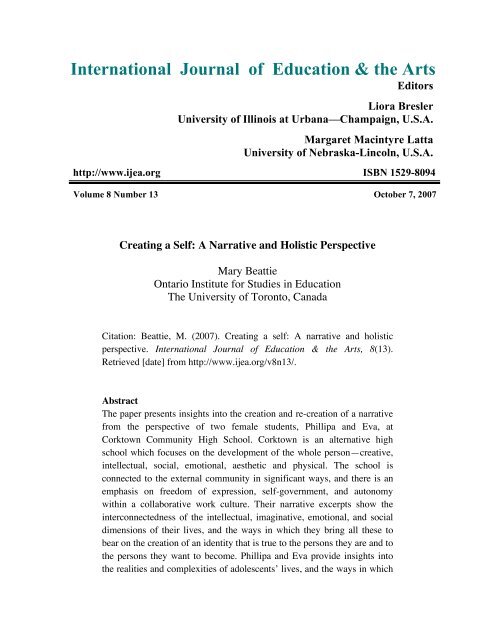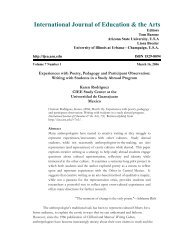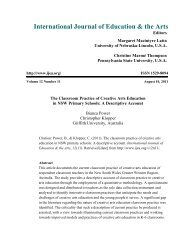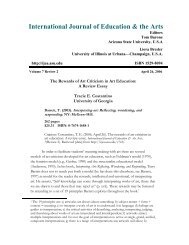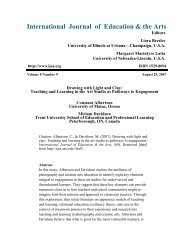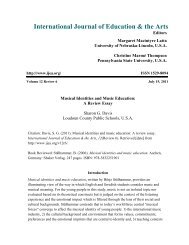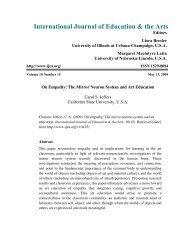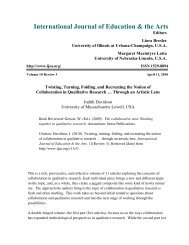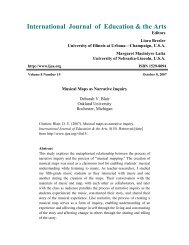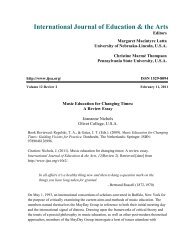Creating a self: A narrative and holistic perspective
Creating a self: A narrative and holistic perspective
Creating a self: A narrative and holistic perspective
You also want an ePaper? Increase the reach of your titles
YUMPU automatically turns print PDFs into web optimized ePapers that Google loves.
IJEA Vol. 8 No. 13 – http://www.ijea.org 10the research would depend on consensus among teachers, students, <strong>and</strong> parents, <strong>and</strong>waited to find out the results of their meeting. The teachers at Corktown emphasized theimportance of anonymity which they had been promised, <strong>and</strong> did not relinquish this evenwhen the other 20 schools in the project decided to do so at the end of the project. Theproject also began with an open discussion of the complexities <strong>and</strong> difficulties of doingthis kind of collaborative, relational research, <strong>and</strong> with teachers <strong>and</strong> students agreeing tothe participatory, inquiry based, nature of the project.The research began in the classrooms, <strong>and</strong> in the observation <strong>and</strong> discussion of teachers’practices. As the principal researcher, I spent in excess of the 20 m<strong>and</strong>atory days in theclassrooms, <strong>and</strong> wrote field notes of my observations <strong>and</strong> conversations. With the otherresearch team members, Suzanne Stiegelbauer <strong>and</strong> Margaret Robertson, we collected datafor the project by conducting interviews with the teachers, school board administrators,parents, alumni, students, <strong>and</strong> community members. The data collection also includedstudent shadowing, document analysis, <strong>and</strong> attendance at a wide range of school <strong>and</strong>extra curricular events, all of which were documented. We focussed on exploring themeaning of school success from the <strong>perspective</strong> of students, teachers, parents, alumni,community members, <strong>and</strong> administrators, <strong>and</strong> on underst<strong>and</strong>ing the reasons for theschool’s success in engaging students, retaining them to graduation, <strong>and</strong> in enabling themto be successful academically <strong>and</strong> personally.It was acknowledged that the research would be collaborative, would involve manyconversations <strong>and</strong> discussions outside the scheduled interviews <strong>and</strong> classroomobservations, <strong>and</strong> that meanings would be made collaboratively. It would be:a collaboration between researcher <strong>and</strong> participants, over time, in a place or series ofplaces, <strong>and</strong> in social interaction with milieus. An inquirer enters this matrix in the midst<strong>and</strong> progresses in this same spirit, concluding the inquiry still in the midst of living <strong>and</strong>telling, reliving <strong>and</strong> retelling, the stories of the experiences that make up peoples’ lives,both individual <strong>and</strong> social. Simply stated . . . <strong>narrative</strong> inquiry is stories lived <strong>and</strong> told.(Cl<strong>and</strong>inin & Connelly, 2000, p. 20)Narrative inquiry as it is used here participates in what is now a long line of qualitativeresearch pioneered by Connelly <strong>and</strong> Cl<strong>and</strong>inin (1994, 1990, 1988), Cl<strong>and</strong>inin <strong>and</strong>Connelly, (2000, 1995), <strong>and</strong> set within the conceptual framework established by thisresearch. This line of research builds on the work of Carr, 1986; Coles, 1989; Dewey,1916, 1934, 1938a, 1938b; Eisner, 1991; Geertz, 1988, 1995; MacIntyre, 1981;Polkinghorne, 1988; Schwab, 1983; Taylor, 1989; <strong>and</strong> others. It continues <strong>and</strong> exp<strong>and</strong>s inthe work of other researchers such as Conle, 1996, 1999, 2000; He <strong>and</strong> Phillion, 2001;<strong>and</strong> others. The research is also grounded in Miller’s (2000, 1996, 1993) work on <strong>holistic</strong>education where the education of the whole person involves making connections between
Beattie: <strong>Creating</strong> a Self 11linear thinking <strong>and</strong> intuition, between mind <strong>and</strong> body, among domains of knowledge,between <strong>self</strong> <strong>and</strong> community, to the earth, <strong>and</strong> between the various dimensions of the<strong>self</strong>.The purpose of <strong>narrative</strong> research is the study of individuals’ experience, <strong>and</strong> it isfocussed on moving the locus of inquiry closer to the persons who are having theexperience <strong>and</strong> away from a knowledge based only in researchers’ observations <strong>and</strong>meaning making. A <strong>narrative</strong> researcher works to inhabit the world of another, tounderst<strong>and</strong> individuals in their own terms, <strong>and</strong> to underst<strong>and</strong> the story which givesmeaning to that individual’s life. Actions <strong>and</strong> decisions are understood as individuals’<strong>narrative</strong>s in action, <strong>and</strong> as the expression of their personal histories <strong>and</strong> biographies in aparticular situation.Collaborative relationships with participants are at the heart of this kind of research, <strong>and</strong>they create a context for dialogue <strong>and</strong> story-telling, sharing ideas, the mutual constructionof interpretations, <strong>and</strong> the co-creation of meanings. The qualities of trust <strong>and</strong> mutualrespect are essential for the kind of shared inquiry where researcher <strong>and</strong> participantsengage in tentative meaning-making, <strong>and</strong> in an interpretive method which is a mutualresearcher-participant reconstruction of meaning. As researchers <strong>and</strong> participantsnegotiate meanings <strong>and</strong> co-create underst<strong>and</strong>ings, they acknowledge their temporalquality, <strong>and</strong> underst<strong>and</strong> that they are subject to ongoing interpretation <strong>and</strong> reconstruction.The study participates in what Eisner (1991) describes:as a history <strong>and</strong> tradition populated by those who have attempted to become bothperceptive <strong>and</strong> articulate about what they have encountered in educational settings. . . <strong>and</strong> not only study intact settings in their ‘natural state’, but try to make senseof those settings through language that is not tied to formalism or to theories thatabstract vivid particulars into oblivion. Each tries to tell a story that has a ring oftruth without compromising figurative or interpretive language. (p.3)It is understood that our <strong>narrative</strong>s are always works in progress, open for reconsideration<strong>and</strong> re-construction, <strong>and</strong> that the stories that have formed us are what we use tocontinuously create <strong>and</strong> re-create our identities <strong>and</strong> the <strong>narrative</strong>s of our lives. It is aliberating <strong>and</strong> life-enhancing process described by the poet Seamus Heaney as"make(ing) hope <strong>and</strong> history rhyme" (in conversation). The creation of identity isunderstood here in the context of the concept of a relational <strong>self</strong> –a <strong>self</strong> shaped <strong>and</strong> givenmeaning in the context of relations with others (Buber, 1965; Gilligan 1982; MacMurray1961; Witherall & Noddings, 1991; <strong>and</strong> Taylor, 1989). Identity is formed in relation withothers <strong>and</strong> in social contexts (Taylor, 1989; Vygotsky, 1992) where individuals makesense of what is going on by actively constructing a world around themselves. Through
IJEA Vol. 8 No. 13 – http://www.ijea.org 12dialogue, conversation <strong>and</strong> interaction with others, individuals construct their identities,know what they know, <strong>and</strong> construct new <strong>narrative</strong>s for their future lives. Theintersection of <strong>narrative</strong>s <strong>and</strong> the influence of others’ voices shape <strong>and</strong> change knowledge(Bakhtin, 1986; Vygotsky, 1992) <strong>and</strong> learning, <strong>and</strong> change takes place as experience isreflected upon in the context of human interaction, <strong>and</strong> is continually modified in thelight of new insights <strong>and</strong> underst<strong>and</strong>ings (Dewey, 1938a, 1938b).Narrative <strong>and</strong> story are primary ways of knowing—a paradigm of meaning creation <strong>and</strong> apowerful way of making sense of experience (Bruner, 1986, Polkinghorne, 1988). It isunderstood that as human beings we live storied lives, <strong>and</strong> "lead storied lives on storiedl<strong>and</strong>scapes" Cl<strong>and</strong>inin <strong>and</strong> Connelly (2000, p. 8). Here, <strong>narrative</strong> is understood not onlyas the organizing principle of experiences <strong>and</strong> actions, but of the <strong>self</strong> who experiences<strong>and</strong> acts (Carr, 1986). The issue of personal identity <strong>and</strong> of the creation of a <strong>narrative</strong> isembedded in the unity of life, the coherence of one’s life story, <strong>and</strong> an individual’s choiceto create one kind of unity in his or her life or another. It draws on MacIntyre’s (1981)concept of <strong>narrative</strong> unity <strong>and</strong> on the "concept of a <strong>self</strong> whose unity resides in the unity ofa <strong>narrative</strong> which links birth to life to death as <strong>narrative</strong> beginning to middle to end"(p.191). For Cl<strong>and</strong>inin <strong>and</strong> Connelly (2000), the telling <strong>and</strong> retelling of stories can beunderstood as the enactment of Dewey’s (1938) emphasis on the reconstruction ofexperience as educative, <strong>and</strong> the process through which growth <strong>and</strong> change take place.Human beings experience the world <strong>narrative</strong>ly, <strong>and</strong> education is understood as theconstruction of personal <strong>and</strong> social stories (Connelly & Cl<strong>and</strong>inin, 1990; Cl<strong>and</strong>inin &Connelly, 2000).Narrative inquiry therefore is seen as an appropriate way in which to research experience<strong>and</strong> to underst<strong>and</strong> it from the <strong>perspective</strong> of the individual who is having the experience(Cl<strong>and</strong>inin & Connelly, 2000). This philosophical <strong>and</strong> conceptual orientation to theresearch allows for the exploration of the meaning of students’ experience as it isunderstood by the students themselves in the context of their unique biographies, <strong>and</strong> as itis given meaning by their past experiences, future goals, <strong>and</strong> purposes. Narrative methodsallow the researcher to acknowledge the values, intentions <strong>and</strong> purposes which give theseindividuals’ lives their meaning, <strong>and</strong> to explore the frameworks within which they makethe links between intellect <strong>and</strong> imagination, between past present <strong>and</strong> future, <strong>and</strong> between<strong>self</strong>, school <strong>and</strong> society. These methods allow for students’ own voices to be heard asthey tell of their experiences, the ways in which they made connections <strong>and</strong> learned to reimaginetheir roles, <strong>and</strong> to create <strong>and</strong> to enact new stories in their lives. The value of a<strong>narrative</strong> inquiry orientation to educational research is explained by Charles Taylor(1989, p.52) who says:The philosophic concern with life as <strong>narrative</strong> involves an emphasis on dialogue,conversation, story, <strong>and</strong> the processes of inquiry <strong>and</strong> reflection on experience that
Beattie: <strong>Creating</strong> a Self 13allow the individual to identify what has personal significance <strong>and</strong> meaning forhim or her personally. These processes help forge a vision of reality that takesaccount of how it was constructed in relation to others, in the context of family<strong>and</strong> community, <strong>and</strong> of the social <strong>and</strong> cultural systems that provide meaning to anindividual’s existence. Here theory <strong>and</strong> practice are connected <strong>and</strong> integrated inthe development of the individual’s voice <strong>and</strong> in the creation of a <strong>narrative</strong> questfor a better state of things. Personal meanings <strong>and</strong> underst<strong>and</strong>ing are madeexplicit <strong>and</strong> placed alongside the concepts, theories, <strong>and</strong> descriptions of practicethat come from others. The <strong>narrative</strong>s we tell <strong>and</strong> enact show our efforts todetermine our places in the world <strong>and</strong> to direct our lives relative to the good.<strong>Creating</strong> a Personal Narrative: Developing a VoicePhillipa <strong>and</strong> Eva were among the students interviewed at Corktown as part of the researchthere. These students emphasized the importance of a learning environment whereadolescents are encouraged to use their own voices to express reality as they know it, <strong>and</strong>to express their (often uninformed) ideas <strong>and</strong> underst<strong>and</strong>ings which provided manyopportunities for them to learn to express themselves in appropriate ways. They spoke ofthe value of classrooms which were informal <strong>and</strong> conversational; the smallness of aschool where people got to know each other; <strong>and</strong> where they were encouraged to talkfreely about their experiences, to let down their guard, <strong>and</strong> be themselves. They explainedthat as they felt listened to <strong>and</strong> respected, they became increasingly more willing to speakopenly <strong>and</strong> honestly about the difficulties they were experiencing, <strong>and</strong> to feel supportedin dealing with them. They also explained that this is especially important for all students,but particularly those who have had a series of negative experiences of schools <strong>and</strong>teachers, who have dropped out of several other schools (as most of these students had),<strong>and</strong> are trying again.The connection between the development of voice, the development of <strong>self</strong>-knowledge,<strong>and</strong> the creation of identity is shown here in Phillipa’s <strong>narrative</strong> account. She tells of theimportance of being "allowed to speak her mind", of "learning about her<strong>self</strong>", <strong>and</strong> of anenvironment that encouraged her to use her voice to become a part of the conversation<strong>and</strong> the community. Phillipa was a Grade 11 student who had attended a mainstream highschool before she dropped out <strong>and</strong> came to Corktown. In her second year at the school,she was doing very well academically, making plans for university, <strong>and</strong> making a majorcontribution to the ongoing maintenance of the school community. Of considerable notewas the contribution Phillipa had made by providing support <strong>and</strong> feedback for severalfemale students who were experiencing difficulties. She had acted as a valuableconfidante over a long period for one female student who was able to leave a negativerelationship because of her help.
Beattie: <strong>Creating</strong> a Self 15Phillipa’s <strong>narrative</strong> excerpt provides insights into the importance of the development ofvoice to the creation of identity, <strong>and</strong> the creation of a new <strong>narrative</strong>. She explains thateverything changed when she was encouraged to "speak her mind." It allowed her tobegin to learn about her<strong>self</strong>, about how she related to other people <strong>and</strong> they to her. Byspeaking out about the issues that were important to her without fear of being silenced orshunned, she developed confidence in her own voice, <strong>and</strong> in her ability to shape <strong>and</strong> to bethe author of her future life. It was only when she learned that she could trust others, feelcared for, <strong>and</strong> accepted for who she was, that she could show her unguarded <strong>self</strong>, <strong>and</strong>voice the confusion, the depression, <strong>and</strong> the complexities she was experiencing.Her <strong>narrative</strong> excerpt highlights the importance of giving adolescents the necessary time<strong>and</strong> support to deal with the negative experiences they have had in the past. Theseexperiences affect their abilities to respect <strong>and</strong> trust the adults in their lives, <strong>and</strong> they needto experience relationships of trust <strong>and</strong> respect so that they can learn otherwise. Herwords also highlight the importance of allowing adolescents to express their frustrations<strong>and</strong> negative feelings <strong>and</strong> of having them validated. As she learned to trust her voice <strong>and</strong>the ability to express her<strong>self</strong>, her identity was given meaning <strong>and</strong> shape within herinteractions with others, <strong>and</strong> she began to see new ways of thinking about her<strong>self</strong>, <strong>and</strong> ofher relationships with others. Phillipa explains that as she did so, she felt a renewedenthusiasm <strong>and</strong> energy, <strong>and</strong> began to make new connections between her<strong>self</strong> <strong>and</strong> theworld around her. Her words provide insights into her underst<strong>and</strong>ings of what she neededin order to learn from her experiences to face the realities <strong>and</strong> challenges of her life <strong>and</strong>not to be defeated by them, <strong>and</strong> to discover purpose, excitement, <strong>and</strong> direction in herpersonal life <strong>and</strong> in her academic studies.Like the workings of the natural world in the poem “Frost at Midnight,” most of theworkings of caring, interpersonal relationships <strong>and</strong> of the learning community atCorktown, take place below the surface of perception <strong>and</strong> underst<strong>and</strong>ing in students’lives. Though these qualities are not always observable or fully understood at anintellectual level by the students who are experiencing them, they are felt <strong>and</strong> intuited atmany different levels. Most students explain that they underst<strong>and</strong> them according to howthey make them feel, <strong>and</strong> the responses they elicit from them. They affect their comfortlevels, their willingness to participate, <strong>and</strong> their imaginative, emotional, <strong>and</strong> moraldevelopment, as well as their intellectual development. Students tell of the many ways inwhich they know that they are respected, <strong>and</strong> valued for who they are, <strong>and</strong> explain thatthey can feel the qualities of caring relationships—kindness, support, affection, respect,empathy, trust <strong>and</strong> inspiration.Like Phillipa, many students at Corktown explained that as they were encouraged tospeak about their real feelings <strong>and</strong> ideas, they felt more inclined to participate in the lifeof the classroom <strong>and</strong> the school, to take on responsibilities in the school community, <strong>and</strong>
IJEA Vol. 8 No. 13 – http://www.ijea.org 16to take a more active role in making positive changes in their own lives. As they builtconfidence <strong>and</strong> <strong>self</strong>-esteem, they also built communication skills. Then, <strong>and</strong> as theylearned to express themselves in increasingly more sophisticated ways, they also began tosee that their own opinions <strong>and</strong> ideas were not universally shared, to be less certain abouttheir own ways of knowing, <strong>and</strong> more open to the voices <strong>and</strong> <strong>perspective</strong>s of others.Some students are openly observant <strong>and</strong> reflective about the qualities of relationships <strong>and</strong>a learning environment where they can let down the defences they have built up aroundthem, express their ideas <strong>and</strong> feelings honestly without fear of judgement <strong>and</strong> criticism,<strong>and</strong> develop their voices <strong>and</strong> their identities. Justin, an alumnus of the school, who hadrecently graduated as a teacher <strong>and</strong> had plans to teach in a third world country, explainedthe significance of these to his retention in the school, <strong>and</strong> to his personal <strong>and</strong> academicsuccess:You might say that I was inspired by some of the teachers at Corktown. . . . Thestudents build a relationship with the teacher, <strong>and</strong> from the relationship you thenhave a responsibility to that relationship. You want to talk to this person <strong>and</strong> to beknown as a good student or whatever, those kinds of regular things. . . . Carolinewas my role model. She was my advisor <strong>and</strong> she was such an inspiration. She wasan incredible teacher <strong>and</strong> that’s no guff. . . . She has most definitely influenced theway I view teaching <strong>and</strong> the way I am as a person. I saw in her so many greatqualities that as a teacher she is who I try to live up to.If there’s a teacher that I try to live up to, if there’s a teacher that I remember, it’sher for sure.Fostering Connectedness: Connecting Self, School <strong>and</strong> SocietyEva’s <strong>narrative</strong> excerpt also focuses on the importance of the development of voice, <strong>and</strong>of a sense of belonging <strong>and</strong> connectedness to the development of her identity. Sheexplains that the development of her voice <strong>and</strong> her ability to make more significantconnections between <strong>self</strong>, school <strong>and</strong> society, took place in the kind of classroom where"you can talk to teachers about things, <strong>and</strong> where teachers help students to makeconnections between their own interests <strong>and</strong> the curriculum." She explained that thelearning environment at Corktown provides students with a lot of freedom: freedom toexpress ideas <strong>and</strong> opinions, even when they are dissenting or deemed to be"unacceptable" when this is done in an acceptable manner; freedom to make choices <strong>and</strong>decisions; freedom to explore one’s own interests in the context of the curriculum; <strong>and</strong>freedom to be the author of one’s own life. However, this freedom does not extend to theviolation of the freedom of others or to the endangerment or destruction of the open, safe,trusting environment of the school. She explained that when this freedom is abused by
IJEA Vol. 8 No. 13 – http://www.ijea.org 18communicate with prospective sponsors, to negotiate mutually beneficial contracts, <strong>and</strong>to connect these projects with the curriculum of the school. Examples of Outreachprojects include working at the Food Bank, assisting a visual artist, working in alaboratory at the local university, film <strong>and</strong> video making, <strong>and</strong> working with elementary orsecondary teachers in their classrooms. These projects provide students with a range ofopportunities to design independent study projects where they can try on roles, exploreinterests <strong>and</strong> plans for their future careers, <strong>and</strong> experiment <strong>and</strong> explore at their own pace,<strong>and</strong> according to their evolving interests <strong>and</strong> levels of maturity. The Outreach programmehas a guiding principle where students must engage in two <strong>self</strong>-actualizing projects foreach altruistic one, <strong>and</strong> this provides them with opportunities to learn about giving backto the community that supports them, of gaining a deeper awareness of communal <strong>and</strong>societal issues, <strong>and</strong> of gaining an underst<strong>and</strong>ing of the importance <strong>and</strong> mutual benefits ofconnectedness <strong>and</strong> commitment to community. Many students explain that Outreachprojects taught them to look at things from new <strong>perspective</strong>s, helped them to seethemselves <strong>and</strong> others in new ways, <strong>and</strong> to come to an underst<strong>and</strong>ing that their ideas <strong>and</strong>ways of being are not universally shared. They also explained that in some of thesesituations, they were required to confront their biases, prejudices, <strong>and</strong> privileges.Not all of these independent Outreach projects have the effect of being transformative,but many of them do enable students to develop an awareness of worlds <strong>and</strong> realitiesbeyond their own, to see the injustices around them <strong>and</strong> to want to do something aboutthem. For some students, these experiences enable them to see themselves in new ways<strong>and</strong> to imagine how they might make a contribution to society in ways other than theyhad previously imagined.Eva’s <strong>narrative</strong> excerpt shows how she made connections between her own interests <strong>and</strong>moral purposes <strong>and</strong> the school curriculum, <strong>and</strong> to come to new underst<strong>and</strong>ings of her<strong>self</strong><strong>and</strong> of the interconnectedness of people <strong>and</strong> things. She tells of the value of a curriculum<strong>and</strong> a context where she "made connections to the real world, <strong>and</strong> to things that weremeaningful." Her voice highlights the links between a sense of belonging <strong>and</strong>commitment to others, to the development of a commitment to both curriculum <strong>and</strong>community, <strong>and</strong> to the development of social consciousness. It also shows how thecreation of identity takes place in a relational context where the connectedness she feltwith the teachers at Corktown influenced <strong>and</strong> shaped her experiences there.EvaWhen I came to Corktown, Yes, I had almost dropped out <strong>and</strong> had a part-timeacting job. I wanted to be connected to the real world <strong>and</strong> to do things that weremeaningful. It is the connection with people that keeps you from dropping out atCorktown. This is what makes you want to come to school even if you don’t go to
Beattie: <strong>Creating</strong> a Self 19class. Teachers are not threatening <strong>and</strong> will talk to you about why you do notcome to their class. The papers I wrote, I did many of them because I felt that Iowed something to the teachers. They had done so much for me, I couldn’t letthem down, so I did it. I couldn’t not do my independent study.Here, everything is connected <strong>and</strong> Outreach is the key. It is so intense; you spenda lot of time here. It is inviting, you can discuss ideas, do work. Whenever I comeinto town, I always come back <strong>and</strong> see the people <strong>and</strong> to be in this atmosphere.I remember sitting in a class (at Corktown) <strong>and</strong> something being said connectedwith things I had just done in another class, <strong>and</strong> it’s all connected to the realworld, <strong>and</strong> you’re not just sitting in an ivory tower. Here, they are trying to teachstudents to put things into a context <strong>and</strong> the courses are all about reality, living inthe world, living in Toronto. Corktown teaches you to have trust in your<strong>self</strong> <strong>and</strong>to trust your judgement.In classes (at Corktown) you can talk to teachers about things. I was in Irma’sPolitics class <strong>and</strong> did a project on Nicaragua. I got so connected to this, soinspired. Then one day I went into a café <strong>and</strong> they had these photographs on thewalls. I said, "Oh God, this is Nicaragua." There was an advertisement on the wallalso. The artist had a write up of the photos <strong>and</strong> the project <strong>and</strong> the phone numberfor volunteers to work there rebuilding schools. I called <strong>and</strong> went there in thesummer for a month. I raised it at a student meeting, <strong>and</strong> it was accepted for theCoffee house proceeds to go to the project. I came back then for the last semester.I did a presentation about the Brigade in one class, <strong>and</strong> in OAC (OntarioAcademic Credit i.e. Graduating Class) I did a paper about the murals ofNicaragua <strong>and</strong> the relationship between politics <strong>and</strong> art. It was all reallyconnected . . . the individual parts <strong>and</strong> the incidents of my life.Eva’s <strong>narrative</strong> excerpt shows how this student made increasingly more significantconnections between the subjects taught in different classes, between the school <strong>and</strong> theoutside world, <strong>and</strong> between her ongoing experiences <strong>and</strong> her continuing academic life.The excerpt shows how the construction <strong>and</strong> reconstruction of her identity took place in arelational <strong>and</strong> communal context where she was encouraged to be creative <strong>and</strong> critical,<strong>and</strong> to continuously explore the interconnectedness of <strong>self</strong>, school <strong>and</strong> society. Her wordstell of how her engagement with the realities of other peoples’ lives, awakened her toissues <strong>and</strong> realities of which she was previously unaware. The discussions in theclassroom at Corktown, the photographs on the café wall, <strong>and</strong> Eva’s own reflectionschallenged her to enter the realities of others less fortunate than her<strong>self</strong>, to connect theseto her own role, responsibilities <strong>and</strong> identity, <strong>and</strong> to create a new <strong>narrative</strong> for her life.
IJEA Vol. 8 No. 13 – http://www.ijea.org 20Drawing on her relationships within the learning community, she came to see that shehad new choices in how she would enact the future of her life, <strong>and</strong> envisioned a way inwhich to tell <strong>and</strong> enact a new <strong>narrative</strong> of her<strong>self</strong>. Her <strong>narrative</strong> excerpt also tells of thedevelopment of her abilities to make increasingly more significant connections betweenher ongoing lived experiences <strong>and</strong> her academic life, <strong>and</strong> of her growing underst<strong>and</strong>ingsof her<strong>self</strong> in the context of school <strong>and</strong> society.<strong>Creating</strong> New Narratives: Always a Work-in-ProgressPhillipa <strong>and</strong> Eva’s <strong>narrative</strong> excerpts are works-in-progress. They are temporal, <strong>and</strong> likesnapshots in time which provide insights into the ways in which their <strong>narrative</strong>s arecontinually being created <strong>and</strong> re-created as new experiences cause them to reorganize,reconstruct <strong>and</strong> transform what they know, <strong>and</strong> to transform the <strong>narrative</strong>s they can tell<strong>and</strong> enact. They tell of how they learned to use their voices to express their realities, togain <strong>self</strong>-knowledge, <strong>and</strong> to make the connections between their own lives, those ofothers <strong>and</strong> their roles in the creation of a just <strong>and</strong> equitable society. Their <strong>narrative</strong>excerpts tell of the influence <strong>and</strong> shaping powers of close relationships <strong>and</strong> good learningexperiences in their lives which have enabled them to create the memories <strong>and</strong> storiesthey used to imagine, plan, <strong>and</strong> create new stories for their lives. They show how this isan ongoing process of moving away from certainties, playing with their edges ofunderst<strong>and</strong>ings, developing their imaginations, making new connections, <strong>and</strong> reimaginingthe possibilities available to them.Phillipa <strong>and</strong> Eva provide insights into the extent to which close relationships <strong>and</strong> asupportive learning environment are at the very heart of learning <strong>and</strong> teaching. Theyshow that from the student’s <strong>perspective</strong>, these are essential to the establishment ofcomfort levels, their willingness to participate, <strong>and</strong> to their sense of belonging. Theyhighlight the importance of providing adolescents with a supportive context in which toexpress the realities of their inner lives, to have support in dealing with them, <strong>and</strong> to havethese interactions with adults who do not deny the emotional work of their own lives butwho model ways of speaking about it <strong>and</strong> managing it. They tell of the mainly indirectways in which they know <strong>and</strong> feel the qualities of kindness, support, empathy <strong>and</strong>affection—<strong>and</strong> of how the sense of being trusted, respected, <strong>and</strong> valued for who they areso greatly influences their learning <strong>and</strong> their lives. They highlight the extent to whichthese qualities are not always observable or fully understood at an intellectual level bystudents, but the extent to which they are felt <strong>and</strong> intuited at so many different levels.They tell of the extent to which they affect the students’ willingness to engageemotionally, morally, imaginatively, <strong>and</strong> intellectually in the school’s curriculum, <strong>and</strong>affect their abilities <strong>and</strong> willingness to engage in weaving the threads of a personalidentity "where hope <strong>and</strong> history (will) rhyme" (Heaney, In conversation)
Beattie: <strong>Creating</strong> a Self 21These <strong>narrative</strong>s are not representative lives <strong>and</strong> do not constitute a statistical sample.What is hoped for is that they do constitute interesting stories which provide insights <strong>and</strong>underst<strong>and</strong>ings which will echo <strong>and</strong> resonate from one life to another. As Mary CatherineBateson (1989) says:We need to look at multiple lives to test <strong>and</strong> shape our own. Growing up with twotalented <strong>and</strong> very different parents, I have never looked for single role models. Ibelieve in the need for multiple models so that it is possible to weave somethingnew from many different threads. (p.16)The story of the school is also a work-in-progress. It too is like a snapshot-in-time of alearning community which is continually being created <strong>and</strong> re-created as each new groupof students <strong>and</strong> teachers collaborate to create the community each day. Every year isdifferent because the community members are different, <strong>and</strong> success is based on theongoing, daily efforts of all community members. The challenges <strong>and</strong> difficulties ofcreating <strong>and</strong> recreating a learning environment such as this year after year cannot beunderestimated. Not all students are successful at Corktown, as not all students areprepared to accept the level of commitment required to take ownership of their ownlearning, to play multiple roles in each others’ lives, to contribute to the smoothfunctioning of the learning community, <strong>and</strong> to take leadership roles in the school. It alsotakes a special kind of teacher to be successful in a small school where six teachers mustteach all subjects <strong>and</strong> play so many roles in students’ lives. This kind of learningenvironment requires students <strong>and</strong> teachers to collaborate with each other <strong>and</strong> withparents, <strong>and</strong> for all to maintain a high level of commitment to each other <strong>and</strong> to thecommunal values <strong>and</strong> philosophy of the school.Teachers <strong>and</strong> students have daily practice in adaptability, responsiveness, <strong>and</strong>reciprocality in this small school where resources are scarce, <strong>and</strong> individuals must worktogether in close relationships as they would in a family setting. These challenges <strong>and</strong>difficulties cannot be overlooked or underestimated. Many of the teachers speak of overexhaustion,related health problems, <strong>and</strong> an over-commitment of time <strong>and</strong> energy to theprofessional part of their lives because of the multiple roles they play in students’ lives.In spite of the obstacles <strong>and</strong> frustrations they experience, both teachers <strong>and</strong> students alsospeak of the rewards of working in close relationships over time, <strong>and</strong> getting to knoweach others’ personalities, passions <strong>and</strong> preoccupations. Teachers also speak of knowingthat the work they do can often lead to unexpected outcomes <strong>and</strong> bring about significant<strong>and</strong> often surprising effects in students’ lives. They also recognize the value of being in aschool where they have the flexibility to be spontaneous in their practice, to be able toseize opportunities that could help students to see situations <strong>and</strong> issues from other<strong>perspective</strong>s which could help them to come to underst<strong>and</strong> worlds outside their own
IJEA Vol. 8 No. 13 – http://www.ijea.org 22experience, <strong>and</strong> enable them to envision <strong>and</strong> enact social change. They value this level ofautonomy, responsibility, <strong>and</strong> spontaneity. The ongoing work of creating <strong>and</strong> re-creatinga learning community such as this resembles the work of creating a good home(Noddings, 2003). Building on the work of Jane Rol<strong>and</strong> Martin (1992), Noddings (2003)explains:The best schools should resemble the best homes. . . . The best homes providecontinuity of caring relations, attend to <strong>and</strong> continuously evaluate both inferred<strong>and</strong> expressed needs, protect from harm without deliberately inflicting pain,communicate so as to develop common <strong>and</strong> individual interests, work togethercooperatively, promote joy in genuine learning, guide moral <strong>and</strong> spiritualdevelopment (including the development of an uneasy conscience), contribute tothe appreciation of the arts <strong>and</strong> other cultural achievements, encourage love ofplace <strong>and</strong> protection of the natural world, <strong>and</strong> educate for both <strong>self</strong>-underst<strong>and</strong>ing<strong>and</strong> group underst<strong>and</strong>ing. (pp. 260-261)Phillipa <strong>and</strong> Eva tell of the importance of engaging their hearts, emotions, <strong>and</strong>imaginations as well as their intellects, in order to help them to express, explore, <strong>and</strong>transcend the limits of their past experiences, their familial, cultural <strong>and</strong> socialconditioning, <strong>and</strong> to transform the <strong>narrative</strong>s that they can tell <strong>and</strong> enact in their lives.Their words can help us to underst<strong>and</strong> the ways in which we can create the kinds ofrelationships <strong>and</strong> learning communities which can be felt at many levels of awareness bystudents, where they can be openly reflective about their experiences <strong>and</strong> can collaboratewith colleagues <strong>and</strong> teachers to connect memory <strong>and</strong> imagination, <strong>and</strong> to create new<strong>narrative</strong>s for their future lives.It is in the backward motion towards the sourceAgainst the stream, that most we see ourselves inThe tribute of the current to the sourceIt is this in nature we are fromIt is most us.(Robert Frost, 1950, “West Running Brook”, p. 329)ReferencesBahktin, M. (1986). Speech genres <strong>and</strong> other late essays. Austin: University of TexasPress.Bateson, M. C. (1989). Composing a life. New York: The Atlantic Monthly Press.
Beattie: <strong>Creating</strong> a Self 23Beattie, M. (1995). Constructing professional knowledge in teaching; A <strong>narrative</strong> ofchange <strong>and</strong> development. New York: Teachers College Press.Beattie, M. (2004). Narratives in the making: Teaching <strong>and</strong> learning at Corktowncommunity high school. Toronto, ON, Canada: University of Toronto Press.Bruner, J. (1986). Actual minds, possible worlds. Cambridge, MA: Harvard UniversityPress.Buber, M. (1965). I <strong>and</strong> thou. (Ronald G. Smith, Trans.). New York: Scribners.Carr, D. (1986). Time, history <strong>and</strong> <strong>narrative</strong>. Indianapolis: Indiana University Press.Carter, C. (1993). The place of story in the study of teaching <strong>and</strong> teacher education.Educational Researcher, 22(1), 5-12.Cl<strong>and</strong>inin, D. J., & Connelly, F. M. (1995). Teachers’ professional knowledgel<strong>and</strong>scapes. New York: Teachers College Press.Cl<strong>and</strong>inin, D. J., & Connelly, F. M. (2000). Narrative inquiry: Experience <strong>and</strong> story inqualitative research. San Francisco, CA: Jossey Bass.Coleridge, S.T. (1974). "Frost at Midnight". In Norton Anthology of English Literature.New York: W.W. Norton. Originally written in 1798.Coles, R. (1989). The call of stories; Teaching <strong>and</strong> the moral imagination. Boston, MA:Houghton Mifflin.Conle, C. (1996). Resonance in pre-service teacher inquiry. American EducationalResearch Journal, 33(2), .297-325.Conle, C. (1999). Why <strong>narrative</strong>? Which <strong>narrative</strong>? Our struggle with time <strong>and</strong> place inteacher education. Curriculum Inquiry, 29(1), 7-33Conle, C. (2000). Narrative inquiry: research tool <strong>and</strong> medium for professionaldevelopment. European Journal of Teacher Education, 23(1), 49-63Connelly, F. M., & Cl<strong>and</strong>inin, D. J. (1988). Teachers as Curriculum Planners:Narratives of experience. New York: Teachers College Press, ColumbiaUniversity.Connelly, F. M., & Cl<strong>and</strong>inin, D. J. (1990). Stories of experience <strong>and</strong> <strong>narrative</strong> inquiry.Educational Researcher, 19(5), 2-14.Connelly, F. M., & Cl<strong>and</strong>inin, D. J. (1994). Telling teaching stories. Teacher EducationQuarterly, 21(2), 145-158.Dewey, J. (1916). Democracy in education. New York: Macmillan.Dewey, J. (1934). Art as experience. New York: Capricorn Books.
IJEA Vol. 8 No. 13 – http://www.ijea.org 24Dewey, J. (1938a). Experience <strong>and</strong> education. New York: Macmillan.Dewey, J. (1938b). Logic: The theory of inquiry. New York: Henry Holt.Eisner, E. (1991). The enlightened eye: Qualitative inquiry <strong>and</strong> the enhancement ofeducational practice. New York: Macmillan.Frost, R. (1959). ‘West Running Brook". In Collected Poems. New York: Henry Holt,Gaskell, J. (1995). Secondary schools in Canada: The National Report of the exemplarySchools Project. Toronto: Canadian Education Association.Geertz, C. (1988). Works <strong>and</strong> lives: The anthropologist as author. Stanford: CA.University Press.Geertz, C. (1995). After the fact: Two countries, four decades, one anthropologist.Cambridge, Mass.: Harvard University Press.Gilligan, C. (1982). In a different voice. Cambridge, MA: Harvard University Press.He, M. F., & Phillion, J. (2001). Trapped in-between: A <strong>narrative</strong> exploration of race,gender <strong>and</strong> class. Journal of Race, Gender <strong>and</strong> Class, 8(10), 47-56.Martin, J. R. (1992). The schoolhome: Rethinking schools for changing families.Cambridge, MA: Harvard University Press.MacIntyre, A. (1981). After virtue: A study in moral theory. London: Gerald Duckworth.MacMurray, J. (1961). Persons in relation. New York: Harper <strong>and</strong> Row. (Original workpublished in 1954)Miller, J. (1993). The <strong>holistic</strong> teacher. Toronto: OISE Press.Miller, J. ( 1996). The <strong>holistic</strong> curriculum. Toronto: OISE Press.Miller, J. (2000). Education <strong>and</strong> the soul. Albany: State University of New York Press.Miller, J. (2005). Educating for wisdom <strong>and</strong> compassion: <strong>Creating</strong> conditions fortimeless learning. Thous<strong>and</strong> Oaks, California: Corwin Press.Noddings, N. (1984). Caring: A feminine approach to ethics <strong>and</strong> moral education.Berkeley, CA: University Press.Noddings, N. (2003). Happiness <strong>and</strong> education. Cambridge, MA: Cambridge UniversityPress.Polkinghorne, D. (1988). Narrative knowing <strong>and</strong> the human sciences. Albany; NY:University Press.Schwab, J. (1983). The practical, 4: Something for curriculum professors to do.Curriculum Inquiry, 13(3), 239-265.Taylor, C. (1989). Sources of the <strong>self</strong>. Cambridge, MA: Harvard University Press.
Beattie: <strong>Creating</strong> a Self 25Vygotsky, L. (1992). Thought <strong>and</strong> language (revised version, A. Kozulin, Ed.).Cambridge, MA: Institute of Technology Press.Witherall, C., & Noddings, N. (1991). (Eds.) Stories lives tell: Narrative <strong>and</strong> dialogue ineducation. New York: Teachers’ College Press.About the AuthorMary Beattie is an Associate Professor at the Ontario Institute for Studies in Education atThe University of Toronto. She is the author of the books Narratives in the Making:Teaching <strong>and</strong> Learning at Corktown Community High School published in 2004 byUniversity of Toronto Press, Constructing Professional Knowledge in Teaching: ANarrative of Change <strong>and</strong> Development published in 1995 by Teachers College Press, <strong>and</strong>The Art of Learning to Teach: <strong>Creating</strong> Professional Narratives (2nd edition) publishedin 2006 by Merrill/Prentice Hall. She recently completed a 5-year in-depth <strong>narrative</strong>inquiry into the learning experiences of eight educators who have longst<strong>and</strong>ing practicesin the arts <strong>and</strong> in mindfulness <strong>and</strong> contemplative practices chosen for their influence <strong>and</strong>conditioning effects. She is preparing a book from the project entitled Narratives ofLifelong Learning.
IJEA Vol. 8 No. 13 – http://www.ijea.org 26International Journal of Education & the ArtsEditorsLiora BreslerUniversity of Illinois at Urbana-Champaign, U.S.A.Margaret Macintyre LattaUniversity of Nebraska-Lincoln, U.S.A.Managing EditorAlex RuthmannIndiana State University, U.S.A.Associate EditorsDavid G. HebertBoston University, U.S.A.Pauline SameshimaWashington State University, U.S.APeter F. AbbsEunice BoardmanNorman DenzinKieran EganElliot EisnerMagne Espel<strong>and</strong>Rita IrwinGary McPhersonJulian Sefton-GreenRobert E. StakeSusan StinsonGraeme SullivanChristine ThompsonElizabeth (Beau)Peter WebsterEditorial BoardUniversity of Sussex, U.K.University of Illinois at Urbana-Champaign, U.S.A.University of Illinois at Urbana-Champaign, U.S.A.Simon Fraser University, CanadaStanford University, U.S.A.Stord/Haugesund University College, NorwayUniversity of British Columbia, CanadaUniversity of Illinois at Urbana-Champaign, U.S.A.University of South Australia, AustraliaUniversity of Illinois at Urbana-Champaign, U.S.A.University of North Carolina—Greensboro , U.S.A.Teachers College, Columbia University, U.S.A.Pennsylvania State University, U.S.A.Valence Indiana University, Bloomington, U.S.A.Northwestern University, U.S.A.


